#NFC applications
Explore tagged Tumblr posts
Text
As we step deeper into the age of digital connectivity, Near Field Communication (NFC) technology is evolving beyond simple tap-and-go functionalities. With the infusion of artificial intelligence (AI), NFC is undergoing a transformation, unlocking a wide range of possibilities that extend far beyond mobile payments. From smarter retail experiences to predictive maintenance in manufacturing and secure healthcare systems, AI-powered NFC applications are reshaping how we interact with digital environments—all without the need to touch a screen or handle a card.
0 notes
Text
0 notes
Text
Bandai Explains Why They Adopted AWS for Tamagotchi Uni and Why NFC Didn’t Work

The partnership of Tamagotchi and Amazon Web Services is so interesting, and we love hearing more about it. Yuri Okamoto of the Bandai planning team of the Toy Division Global Toy Planning Department, who was in charge of the planning and development of the Tamagotchi Uni at Bandai, and Daisuke Sakammoto of the technical design team of the same department explain further why exactly Bandai adopted AWS for the new Tamagotchi Uni.
Mr. Okamoto explains that the first connectivity method was introduced in 1997 with the Tamagotchi Osutchi and Mesutchi. The purpose of this connectivity was for one character to be able to cross over into the other device.
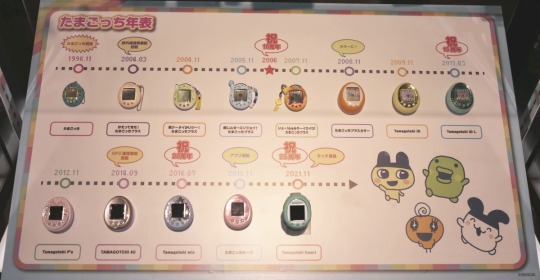
Then in March of 2004, after the explosive boom of Tamagotchi calmed down, the Tamagotchi Plus model was introduced with new infrared communication. The infrared technology functionality was the exact function that was tailored in the heyday of feature phones in Japan, and it was possible not only to connect two Tamagotchi’s together, but also to mobile phones.
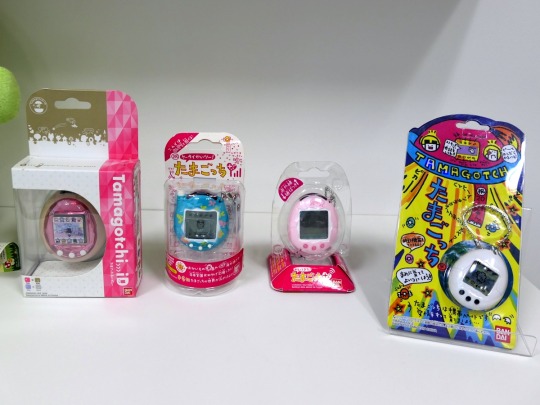
Newer models also introduced different types of connectivity, including NFC with the Tamagotchi 4U in 2014. NFC was aimed to allow Tamagotchi’s to connect together by touching the devices together. However, the communication speed of NFC was not very fast, so it did not become a user experience the communication would end when touched.
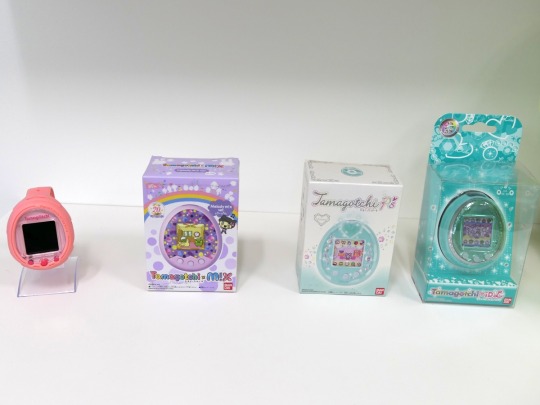
Tamagotchi M!X back in 2016 brought back the infrared connectivity. The Tamagotchi Meets back in 2018 then introduced Bluetooth connectivity on top of the infrared functionality which enable the ability to connect to a smartphone or tablet to use the application.
The Tamagotchi Smart which was released in the midst of the COVID-19 global pandemic where contact with people was suppressed. The Tamagotchi Smart allowed caretakers to interact with their Tamagotchi with the use of voice and touch, along with wearing your Tamagotchi Smart right on your wrist.
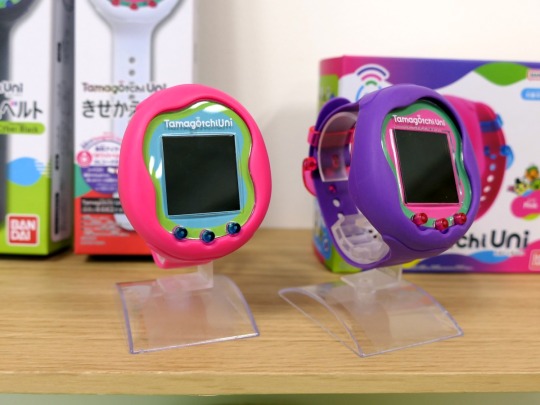
Mr. Okamoto then discusses how the Tamagotchi demand has been higher overseas than in Japan. The Tamagotchi Uni was sought out to unify the design and content of play sot hat Tamagotchi users around the world can enjoy the same Tamagotchi Uni globally.
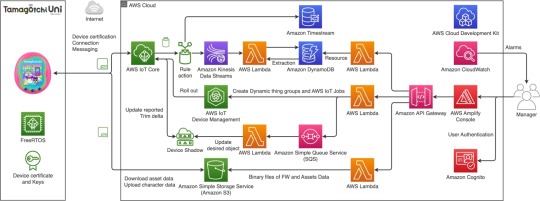
The Tamagotchi Uni also introduced Wi-Fi for the first time. This enables the new Tamaverse feature, software updates, and more. There are a wide range of functions that should be independently implemented in the cloud infrastructure to realize the concept of the Tamagotchi Uni. AWS has great infrastructure capabilities and a range of sample documents to advance development.
Monoist asks if future models after the Tamagotchi Uni will feature cloud connectivity. Mr. Okamoto responds that there alway needs to be the core play that has always been featured in the Tamagotchi, and Bandai will consider how to do that with both hardware and software. So the cloud is not necessarily a requirement for the next generation model.
#tamapalace#tamagotchi#tmgc#tamatag#virtualpet#bandai#jp#yuriokamoto#yuri okamoto#daisukesakamoto#daisuke sakamoto#monoist#aws#amazonwebservices#amazon web services#nfc
27 notes
·
View notes
Text
🌟PO - Lovebrush Chronicles 时空中的绘旅人 For All Time December Official Merch 🌟
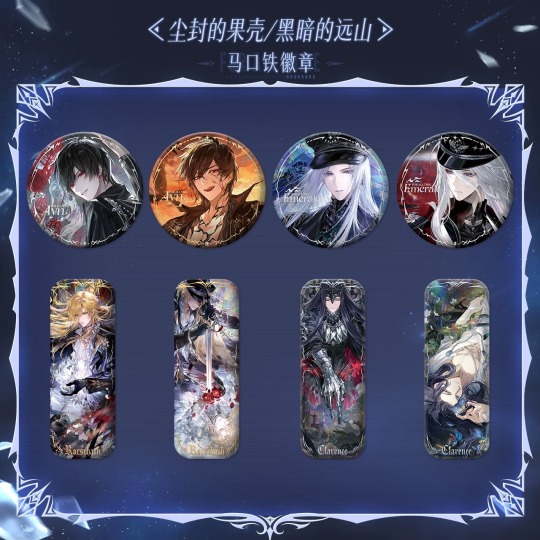

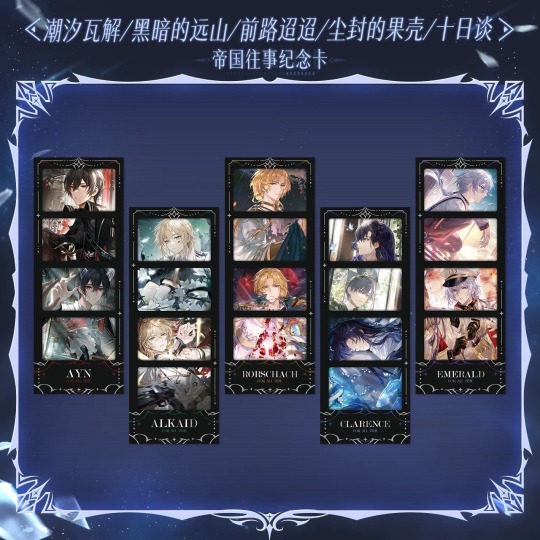
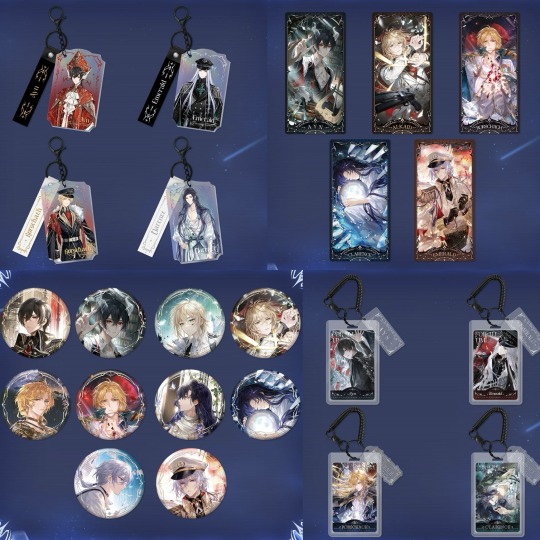

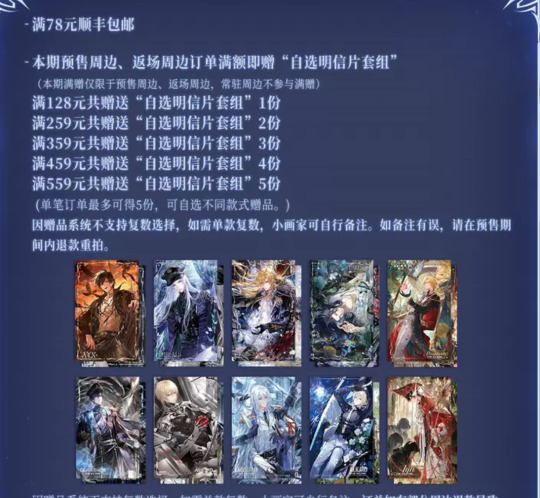

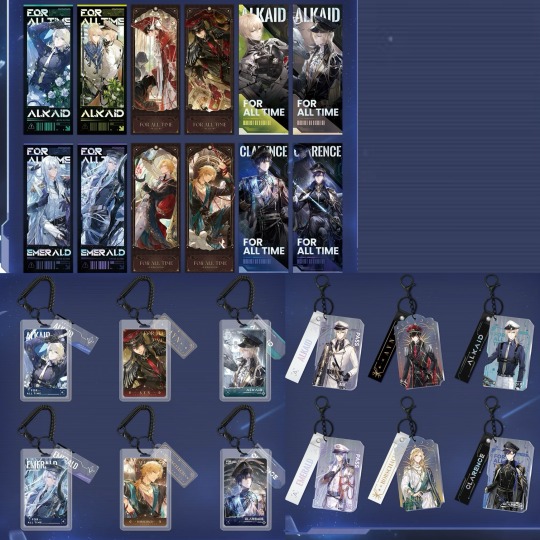
ETA: July 2025
Payment Deadline: 29 December 2024, 20:00 SGT
➡️ Prices are in Singapore dollar and includes shipping from source country to me. Do note that mailing to you is additional. Paypal and Wise are accepted for international buyers.
➡️ Purchase Bonus: For every 128p, 259p, 359p, 459p, 559p milestones reached, you can choose one character’s 2-pc bromide set. (10 types to choose from).
✅ DM to Order:
Too many to list, so DM me for the prices instead 💕
Feel free to ask for zoomed in pics!
🌟尘风的果壳/ 黑暗的远山🌟
(15p) Can Badge
(25p) Shikishi
(13.9p) Chrome Ticket
(48p) Shiny Acrylic Display
(45p) Acrylic Stand
(28p) Acrylic Keyholder
(79p) Acrylic Transport Card Holder (with NFC features, but may be limited to China)
🌟 潮汐瓦解/前路迢迢/十日谈🌟
(25p) 2-pc badge set
(13.9p) Collection Card
(13.9p) Film Card
🌟 漆灯夜照🌟
(15p) Square Can Badge
(20p) Polaroid Set
(13.9p) Collection Card
(45p) Acrylic Postcard
🌟 Rerun Merch - Pic 7 & 8🌟
(Not applicable for bonuses)
DM me to enquire on the prices!
#lovebrushchronicles #lbcmerch #时空中的绘旅人 #foralltime #otome #otomemerch
3 notes
·
View notes
Text
#NikeCHANEL
[ #Nike X #CHANEL limited collection exclusively designed for SnoopDoggs Marvel Comic]




Expanding the Nike x Chanel collection would offer a wide range of designs and styles to appeal to different tastes. Here's a detailed expansion of the collection:
Variations in Colors and Textures
Color Combinations:
Monochrome Glam: All-white or all-black sneakers with gold or silver Chanel 'C's for an understated luxury vibe.
Neon Pop: Fluorescent green and orange for a bold, edgy streetwear aesthetic.
Pastel Dreams: Lavender and mint green tones with subtle metallic accents.
Gradient Design: A smooth gradient from pink to purple or yellow to orange, symbolizing vibrancy and motion.
Textural Enhancements:
Matte Leather: Combine matte leather with glossy patent details for contrast.
Shearling Trim: A winter edition with Chanel shearling on the ankle collar for warmth and style.
Denim and Silk: Casual luxury using Chanel denim paired with silk shoelaces.
Themed Editions
Seasonal Styles:
Spring Edition: Floral-inspired patterns with pastel colors and embroidered Chanel flowers.
Summer Edition: Bright tones with breathable mesh for a lightweight feel.
Fall Edition: Earthy hues like browns, oranges, and greens with houndstooth panels.
Winter Edition: Deep navy or burgundy with quilted leather resembling Chanel handbags.
Iconic Landmark Editions:
Paris: Features the Eiffel Tower silhouette and a black-and-white striped tweed, reminiscent of Parisian chic.
Los Angeles: Incorporates palm tree motifs with vibrant sunset colors.
Special Collaborations
Celebrities:
A Pharrell Williams version focusing on vibrant, playful designs.
A Billie Eilish eco-conscious version, using sustainable materials like vegan leather and recycled textiles.
Luxury Fusion:
Incorporate Tiffany Blue elements with diamond-like accents for an ultra-luxury edition.
Collaborate with other fashion houses like Dior or Gucci for crossover appeal.
Functional Upgrades
Technology Integration:
Smart insoles to track steps and activity levels.
NFC tags for authentication and access to exclusive digital content, like behind-the-scenes of the collaboration.
Comfort Features:
Air Cushions: Enhanced Nike Air technology for added comfort.
Waterproof Coatings: Practical for all-weather use.
Limited-Edition Packaging
Collectible boxes featuring Chanel's quilted patterns and the iconic Nike swoosh. Some versions could come with custom dust bags and shoe care kits.
Accessories and Apparel
Matching apparel, including jackets, tracksuits, and hats, featuring the same color schemes and materials.
Bags and pouches with mini Nike swoosh and Chanel 'C' logos.
Would you like me to focus on any specific category or create visual concepts for some of these designs?


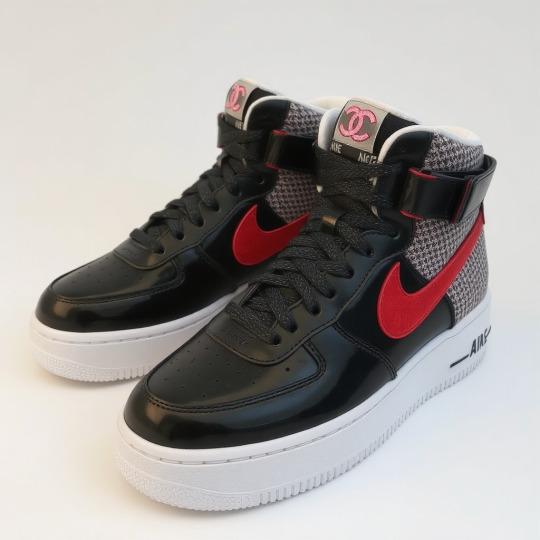
Chanel is renowned for its luxurious and timeless textiles and patterns, many of which could be incorporated into designs for collaborations like the Nike x Chanel sneakers. Below is a breakdown of Chanel's iconic materials and patterns:
Tweed
Signature Material: Chanel’s tweed is the hallmark of its design, often woven with intricate patterns and a mix of colors.
Types:
Classic Black and White Tweed.
Multicolored tweeds featuring pastel or bold hues.
Metallic Tweed interwoven with gold or silver threads for a glamorous touch.
Quilted Patterns
Iconic Quilting: The diamond quilt pattern is synonymous with Chanel bags and accessories.
Applications: Perfect for adding texture and elegance, particularly on leather panels of sneakers.
Houndstooth
Timeless Pattern: Black-and-white houndstooth is a staple in Chanel collections, symbolizing sophistication and class.
Variations: Sometimes reimagined in color for modern or seasonal updates.
Bouclé
Textured Fabric: Bouclé is a woven textile with a looped or curly surface, giving it a unique texture.
Use: Adds a sense of luxury and warmth, often found in Chanel jackets and skirts.
Camellia Motif
Floral Pattern: The camellia is Chanel’s signature flower, often appearing in embroidered or printed textiles.
Options:
Monochromatic camellia prints.
Subtle embossing or tonal designs for understated elegance.
Stripes
Parisian Influence: Chanel often features classic horizontal or vertical stripes, especially in nautical-inspired collections.
Use: Could be a fun, retro element for sneaker lining or laces.
Chain Motif
Metal Accents: The chain motif, inspired by Chanel’s handbag straps, is often incorporated into prints or embroidered onto textiles.
Applications: Metallic detailing around the shoe collar or lace eyelets.
Luxe Fabrics
Silk and Satin: Chanel frequently uses these soft, lustrous fabrics in its apparel and could incorporate them into sneaker linings or laces.
Velvet: Adds richness and depth, suitable for limited-edition sneaker designs.
Would you like to explore how specific materials or patterns could be applied to different parts of the sneaker?




4 notes
·
View notes
Text
Near Field Communication 101: The Tiny Tech Creating Billion-Dollar Opportunities

Executive Overview of the Near Field Communication Market's Strategic Expansion
We are currently witnessing a revolutionary transformation across industries as near field communication market technology becomes the backbone of secure, swift, and seamless data transfer. As digital ecosystems evolve, NFC has become central to contactless communication, reshaping consumer experience, supply chains, urban mobility, healthcare delivery, and digital finance. By 2032, the global Near Field Communication Market is poised to exceed $90 billion, driven by innovation in smart devices, the exponential rise of IoT infrastructure, and increased adoption across emerging economies.
Request Sample Report PDF (including TOC, Graphs & Tables): https://www.statsandresearch.com/request-sample/40595-global-nfc-market-trends-2025-near-field-communication-industry-growth
Surge of Near Field Communication Market in the Contactless Economy
NFC's Ubiquity in Smart Payments and Digital Wallets
As consumers globally gravitate toward frictionless transactions, NFC-based mobile wallets have surged in prominence. Market leaders like Apple Pay, Google Pay, and Samsung Pay are deeply integrated into everyday retail experiences, particularly in Asia-Pacific and Europe, where smartphone penetration has crossed 85%. The proliferation of NFC-enabled POS terminals is redefining digital retail, banking, and hospitality operations.
Additionally, NFC’s dual-interface capability enables secure EMV transactions in both online and offline environments—making it a preferred solution in financial ecosystems focused on low-latency and high-security authentication.
Get up to 30%-40% Discount: https://www.statsandresearch.com/check-discount/40595-global-nfc-market-trends-2025-near-field-communication-industry-growth
Strategic Role in IoT and Smart Infrastructure
IoT Integration and Industrial Automation
Near field communication market is a critical pillar in enabling machine-to-machine communication within smart homes, industrial automation, and logistics tracking. In logistics, NFC tags and readers allow for real-time shipment monitoring, quality control, and authentication, helping companies reduce counterfeit risk and operational inefficiencies.
In smart cities, NFC supports transit systems, municipal identification, and public facility access. The synergy between NFC and IoT allows cities to harness real-time data to optimize infrastructure usage and improve civic services.
Sectoral Penetration: Industry-by-Industry Analysis
Healthcare Transformation via Secure NFC Connectivity
From electronic health records (EHRs) to asset tracking and patient authentication, NFC is embedded into modern healthcare ecosystems. Medical devices equipped with NFC enable real-time monitoring, remote diagnostics, and medication adherence tracking, improving both patient outcomes and operational workflows. Key players such as Abbott and Philips are actively deploying NFC for secure device pairing and data transmission.
Automotive Innovations and Digital Key Integration
Modern vehicles are now equipped with NFC-powered digital keys, offering drivers seamless access and ignition through smartphones or wearable devices. Automotive OEMs like BMW and Hyundai are leading the deployment of digital car keys using standardized NFC protocols, ensuring universal compatibility and secure encryption.
Competitive Landscape: Pioneers and Strategic Collaborations
Leading Innovators Driving NFC Adoption
NXP Semiconductors continues to dominate chip manufacturing with the launch of high-security NFC modules tailored for FinTech and e-government applications.
Sony and Qualcomm are deeply invested in NFC chipsets for next-gen consumer electronics.
Visa and Mastercard are expanding wearable NFC payment ecosystems, fostering innovation in the lifestyle tech sector.
Strategic alliances between hardware vendors, platform developers, and telecom operators are accelerating global NFC adoption. For instance, partnerships between fintech startups and NFC platform providers are creating scalable, API-friendly digital payment ecosystems in Southeast Asia and Africa.
NFC Security Architecture: High Trust in Short-Range Protocols
Unlike other wireless standards, NFC’s inherently short operational range (typically <4 cm) creates a security advantage. Layered encryption, tokenization, and secure element technology further enhance transaction safety. As global regulations around data privacy tighten (e.g., GDPR, CCPA), NFC's architecture positions it as a preferred technology for compliance-ready secure communication.
Innovation Outlook: Emerging Tech Synergies
AI, Blockchain, and Machine Learning
The convergence of NFC with AI and blockchain technologies is laying the groundwork for intelligent, traceable, and self-learning systems. For example:
AI-powered NFC apps offer hyper-personalized promotions in retail.
Blockchain-integrated NFC enables secure and immutable transaction logs in supply chains, enhancing trust and traceability.
ML models trained on NFC-enabled behavioral data are revolutionizing predictive analytics in marketing and operations.
Regional Growth Trajectories: Global Demand Matrix
Asia-Pacific: The NFC Powerhouse
With rapid urbanization and government-led cashless initiatives, countries like China, South Korea, India, and Singapore are setting the pace for NFC adoption. Government programs such as India's “Digital India” and Korea’s “Smart City” initiative are significant catalysts.
Europe and North America: Consolidated Maturity and Advanced Use-Cases
In these mature markets, NFC growth is being driven by innovation in wearables, healthcare devices, and automotive sectors. NFC-enabled biometric passports and citizen IDs are now standard across many EU countries.
Latin America, Middle East & Africa: Untapped Potential
Financial inclusion initiatives and mobile-first economies offer fertile ground for NFC expansion. In Africa, mobile banking systems like M-Pesa are integrating NFC to bring advanced financial services to unbanked populations.
Near Field Communication Market Segmentation Analysis
Near Field Communication Market By Offering:
Hardware: NFC-enabled smartphones, POS systems, wearable devices.
Platform: Enterprise-grade SDKs, middleware, secure element OS.
Near Field Communication Market By Product Type:
NFC Tags & Labels
NFC Readers
NFC Chips
Embedded Devices
Near Field Communication Market By Application:
Mobile Payments
Healthcare Device Pairing
Access Control Systems
Consumer Electronics Pairing
Smart Transportation & Ticketing
Near Field Communication Market By End-User:
Retail & E-commerce
BFSI
Healthcare
IT & Telecom
Automotive
Public Sector & Defense
Future Forecast and Near Field Communication Market Trajectory
By 2032, the Near Field Communication Market is projected to achieve a CAGR of 14.2%, propelled by:
Accelerated deployment of 5G networks facilitating NFC-cloud synergies
Growth of smart appliances and NFC-enabled consumer devices
Rise in contactless and biometric-authenticated transactions
Standardization of NFC protocols across devices and platforms
Purchase Exclusive Report: https://www.statsandresearch.com/enquire-before/40595-global-nfc-market-trends-2025-near-field-communication-industry-growth
Conclusion
The near field communication market stands as a pillar of the contactless future. From healthcare to retail, transportation to telecom, the technology is seamlessly embedding itself across vital sectors. Backed by robust security, low implementation cost, and ease of integration, NFC is primed for exponential growth. Companies leveraging NFC’s full potential—through strategic innovation, regional expansion, and synergistic tech integration—are set to define the next era of digital communication and commerce.
Our Services:
On-Demand Reports: https://www.statsandresearch.com/on-demand-reports
Subscription Plans: https://www.statsandresearch.com/subscription-plans
Consulting Services: https://www.statsandresearch.com/consulting-services
ESG Solutions: https://www.statsandresearch.com/esg-solutions
Contact Us:
Stats and Research
Email: [email protected]
Phone: +91 8530698844
Website: https://www.statsandresearch.com
1 note
·
View note
Text
How Customer Experience is Being Transformed This Year by Utility Payment Solutions ?

In recent years, the landscape of utility payment solutions has undergone a significant transformation driven by advancements in fintech. These changes have not only streamlined processes but have also profoundly impacted customer experience. From enhanced convenience to improved security measures, utility payment solutions have evolved to meet the growing demands of both consumers and utility providers alike.
1. Convenience and Accessibility
One of the most noticeable transformations in utility payment solutions is the increased convenience they offer customers. Traditionally, paying utility bills involved manual processes such as visiting payment centers or mailing checks, which could be time-consuming and inconvenient. Today, fintech solutions have revolutionized this process by introducing online platforms and mobile applications. These platforms allow customers to pay their bills anytime, anywhere, using various payment methods such as credit/debit cards, bank transfers, or digital wallets. This flexibility not only saves time but also enhances accessibility, catering to a broader range of preferences and lifestyles.
2. Integration and Automation
Integration of utility payment solutions with other financial tools and services has also significantly enhanced customer experience. Modern fintech solutions often integrate seamlessly with personal finance management apps, allowing users to track their utility expenses alongside other expenditures. This integration provides customers with a holistic view of their financial health and helps in budgeting effectively. Moreover, automation features offered by these solutions enable customers to set up recurring payments or receive reminders, reducing the likelihood of missed payments and associated penalties. Such automation not only saves time but also improves financial planning and peace of mind for consumers.
3. Enhanced Security Measures
Security has always been a critical concern when it comes to financial transactions, and utility payments are no exception. Fintech solutions have introduced robust security measures to protect customers' sensitive information and transactions. Advanced encryption techniques safeguard data during transmission, ensuring that personal and financial details remain secure. Additionally, authentication methods such as biometrics or two-factor authentication (2FA) add an extra layer of security, preventing unauthorized access to accounts. These security enhancements not only build trust among customers but also mitigate risks associated with fraud and identity theft, thereby enhancing overall customer experience.
4. Personalization and Customer Engagement
Another significant transformation brought about by utility payment solutions is the focus on personalization and customer engagement. Fintech platforms leverage data analytics to understand customer behavior and preferences better. By analyzing past payment patterns, these solutions can offer personalized recommendations, such as suggesting the most convenient payment method or notifying customers about potential savings through energy-efficient practices. Furthermore, interactive customer support features, such as chatbots or live customer service representatives, ensure prompt resolution of queries and issues, thereby enhancing overall satisfaction and engagement.
5. Innovation in Payment Technologies
The evolution of payment technologies has also contributed to transforming customer experience in utility payments. Contactless payments, enabled through Near Field Communication (NFC) technology or QR codes, have gained popularity due to their convenience and speed. Customers can now simply tap their smartphones or scan a code to make payments, eliminating the need for physical cards or cash. Moreover, emerging technologies like blockchain are being explored to further enhance security and transparency in utility payment transactions. These innovations not only improve efficiency but also pave the way for future advancements in the fintech software sector.
6. Sustainability and Eco-Friendliness
Utility payment solutions are increasingly aligning with sustainability initiatives, contributing to a greener future. Many fintech platforms now offer paperless billing options, allowing customers to receive and manage bills digitally instead of in print. This not only reduces paper waste but also supports environmental conservation efforts. Furthermore, by promoting energy-saving practices and providing insights into consumption patterns, these solutions empower customers to make informed decisions that contribute to a more sustainable lifestyle. Such initiatives resonate with environmentally conscious consumers, thereby enhancing their overall satisfaction with utility payment services.
Conclusion
In conclusion, utility payment solutions have undergone a remarkable transformation in recent years, driven by advancements in fintech. These innovations have not only enhanced convenience, security, and accessibility but have also personalized customer experiences and promoted sustainability. As technology continues to evolve, utility payment solutions are expected to further improve, offering even greater benefits to consumers and utility providers alike. By embracing these advancements, businesses can foster stronger customer relationships and adapt to the changing demands of the digital age effectively. Thus, the future of utility payments looks promising, with continued emphasis on innovation, security, and customer-centricity shaping the landscape of customer experience in this sector.
2 notes
·
View notes
Text
Industry trend|A solution provider for the world's top three retailers is studying the use of RFID
Driven by the wave of digitalization, Fabacus, a global data and technology company, is leading retailers and brands into a new era of Digital Product Passport (DPP) compliance with its innovative solutions. As the European Commission proposes new regulations on DPP, Fabacus, with its deep industry experience and advanced technical means, provides the market with a complete set of solutions to help companies easily cope with the upcoming compliance challenges.
Since its establishment six years ago, Fabacus has been committed to providing services and software platforms, including licensing, to retailers and brands. Faced with the compliance requirements of DPP, Fabacus responded quickly and developed a solution called Xelacore. This solution provides unique item-level identification for products through QR code technology, allowing retailers and brands to easily meet the DPP's requirements for product traceability. Tesco, one of the world's three largest retailers, has taken the lead in adopting this solution and applied it to the F&F clothing series, providing consumers with more transparent and reliable product information.
Fusion of RFID and NFC technologies
In addition to QR codes, Fabacus is also actively exploring the fusion of RFID and NFC technologies. Founder and CEO Andrew Xeni said the company is working with several companies that already use RFID technology for inventory tracking, and plans to use Fabacus's solution to make these RFID tags meet the requirements of DPP at the same time. This hybrid solution not only improves the efficiency of inventory management, but also provides consumers with a more convenient way to access DPP data. For example, consumers can easily obtain detailed information about product materials and manufacturing history by scanning the QR code or NFC tag on the product with their mobile phone.
In addition to DPP compliance, Fabacus also pays attention to the new requirements for retailers and brands put forward by the Sustainable Product Ecodesign Regulation (ESPR) issued by the European Commission. The regulation aims to improve the sustainability and circularity of products and requires companies to provide detailed information about the product life cycle, including environmental impact, repair instructions, disposal and recycling methods, etc. Fabacus integrates and displays this information in a digital way through its system to help companies and consumers better understand and practice the concept of sustainable development.
Initially, Fabacus's solution focused on the intellectual property licensing industry for brands and retailers. By creating a record system for each new product, Fabacus helps customers protect their intellectual property and revenue and prevent the emergence of counterfeit products. However, as the market changes and new regulations such as the DPP are introduced, Fabacus quickly adjusted its strategic direction and reshaped itself into a provider of DPP compliance and licensing. Xeni said that the technology they have built is very suitable for solving DPP compliance issues and will play an increasingly important role after the DPP legislation comes into effect.
Looking forward, Fabacus will continue to leverage its technological advantages and market insights to provide retailers and brands with more comprehensive and efficient DPP compliance solutions. Through the integrated application of technologies such as RFID, NFC and QR codes, Fabacus will further improve the efficiency of data collection and processing, and provide enterprises and consumers with more convenient and reliable product information query services. At the same time, as the world's attention to sustainable development and circular economy continues to increase, Fabacus will continue to pay attention to the dynamic changes of regulations such as ESPR, and provide enterprises with more comprehensive compliance support and services.
This paper is from Ulink Media, Shenzhen, China, the organizer of IOTE EXPO (IoT Expo in China)
1 note
·
View note
Text
Point of Sales (PoS) Printers Market Sees Growth Fueled by Retail Digitization and Automation Trends
In today's world, point‑of‑sale (PoS) and receipt printing remain foundational to retail, hospitality, healthcare, and various service industries. Though it may seem like a mature segment, the point of sales (PoS) printers market is undergoing transformation, driven by rapid shifts in technology, buying behavior, and regulatory trends. Let us unpack the current scenario, major players, market drivers, key challenges, and where the future is headed.
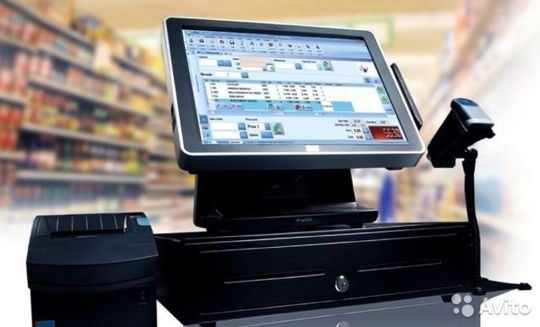
Market Size & Growth
From 2019 to 2023, the global PoS printer market posted a robust compound annual growth rate (CAGR) of approximately 12.3%, increasing in value from USD 7.7 billion in 2019 to about USD 12.65 billion in 2023. Looking ahead, projections indicate continued momentum: Credence Research estimates an expansion from USD 14.3 billion in 2024 to USD 39.5 billion by 2032 (CAGR ~13.5 %), while DataHorizzon anticipates growth from USD 3.53 billion in 2024 to USD 6.06 billion by 2033 at a CAGR of 6.2 %. Despite differences in market definitions and scopes, consensus remains strong: significant growth is forecast across the next decade.
Key Drivers Fueling Expansion
Retail, Hospitality & Healthcare Growth The explosion of organized retail, quick-service eateries, pharmacies, and clinics drives demand for fast, accurate printing. Retailers in North America report over 70% deployment of thermal PoS printers, while approximately 35% of foodservice businesses have adopted mobile printing units. Meanwhile, thermal printing dominates with a 70 %+ market share across applications .
Rise of Mobile & Wireless Printing A shift toward mobile PoS (mPoS) printers especially Bluetooth- and Wi‑Fi-enabled devices is visible across restaurants, pop-ups, and remote retail setups. The emergence of compact, battery-powered printers enables on-the-spot billing and improved customer engagement.
Cloud Integration & IoT Connectivity Cloud-based printing and printer management enabling centralized firmware updates, real-time analytics, and remote configuration have become integral. Over 30% of printer installations support cloud integration; approximately 45% now include Bluetooth connectivity.
Sustainability & Regulatory Pressures Eco-conscious firms are opting for energy-efficient printers built from recycled plastics, along with innovations in recyclable thermal papers. Government regulations such as EU circular economy initiatives are pushing the industry in a greener direction .
Digital Payments & E‑Receipts Rising adoption of contactless and digital transactions demands printers compatible with QR codes, NFC, and durable barcode technologies. Many devices are now tailored for digital and e‑receipt generation.
Market Segmentation & Regional Highlights
SegmentHighlights, By TechnologyThermal printers dominate (>70% global share) with fast, maintenance-free operation. Impact and inkjet units persist primarily in niche sectors. |By Form FactorDesktop printers are widely used in fixed POS systems, while mobile and wireless models grow rapidly in foodservice and event environments. By End‑User IndustryRetail (~45%) leads in adoption, followed by hospitality, healthcare, and ticketing. The healthcare segment is also seeing increased uptake.
Regional Insights:
Asia-Pacific is the fastest-growing region, fueled by urbanization, economic rise in China and India, and government pushes for digital payments. Asia accounts for ~20–25% of the market, with projected CAGRs of 7–8 %.
North America, the most mature market, holds about 30–38 % share, led by strong uptake of advanced desktop and mobile printers.
Europe accounts for ~28 % share, with growth driven by retail and hospitality, sustainability mandates, and fiscal regulations .
Latin America and MEA are smaller but growing markets (~6–10 % combined share), with high adoption among pharmacies, retail chains, and new hospitality ventures.
Competitive Landscape
The market remains competitive and fragmented:
Tier‑1 players: Epson, Star Micronics, Zebra, Bixolon, Citizen lead global market share (roughly 55–60%), thanks to strong R&D and product diversification.
Tier‑2 vendors: Brother, Dymo, TSC offer specialized, industry-specific printers.
Tier‑3 and regional niche players cater to small businesses with cost-effective solutions, often undercutting on price but offering local service and customization .
Market activity is intensifying with frequent tech-led launches (e.g., Epson's eco‑printers, HP’s cloud‑ready models) and partnerships with software providers. Industry consolidation is also underway, as bigger companies absorb innovative startups to enhance portfolios.
Challenges & Restraints
High setup and upkeep costs: Initial investments, consumables (paper), and repairs pose challenges particularly for SMEs.
Digital shift to paperless receipts: As digital alternatives gain traction, demand for printed receipts may decline in developed economies.
Compatibility and system integration: Legacy systems and disparate platforms may restrict adoption of modern printers.
Security concerns: Printers in transactional environments must maintain high standards of data protection to meet regulatory requirements.
Future Outlook & Opportunities
IoT and AI integration: Cloud connectivity, remote firmware updates, predictive maintenance, and analytics-powered printers will shape next-gen PoS ecosystems.
Next‑gen compact and multifunction printers: Devices that combine printing, scanning, and payment acceptance reduce counter clutter and enhance scalability.
Customized receipts as marketing tools: QR codes, brand messaging, coupons printed directly on receipts offer monetization and loyalty-building opportunities.
Growth in emerging markets: Untapped retail and hospitality sectors in Africa, Southeast Asia, and Latin America present significant expansion potential.
Health‑sector innovation: Increasing adoption of PoS printers for patient IDs, labels, prescriptions, and secure transactional printouts.
Conclusion
The PoS printer market is far from static. Bolstered by strong demand in key verticals, rapid technological innovation, and rising adoption in emerging economies, it’s set for sustained, double-digit expansion. Thermal printers maintain dominance, but on-the-go mobile and IoT-enabled devices are emerging as vital tools. Manufacturers addressing cost, eco‑friendliness, AI, and system integration will flourish in the next wave. For businesses, aligning investments with mobility, cloud connectivity, and sustainability will define competitive advantage in tomorrow’s retail and service landscapes.
0 notes
Text
NFC Bracelets Manufacturer Smart Wearable Solutions for the Modern World
In today’s fast-paced digital world, NFC (Near Field Communication) technology has become a core component of smart devices and wearable tech. Among the most innovative applications of NFC are NFC bracelets, which are now widely used for contactless payments, access control, event management, health tracking, and identity verification.
0 notes
Text
Near Field Communication Market Drivers Accelerating Global Adoption and Innovation
The near field communication market is witnessing unprecedented growth as industries and consumers increasingly rely on contactless, secure, and seamless communication technologies. NFC, a short-range wireless connectivity standard, is reshaping interactions between devices, enabling everything from mobile payments to smart access control. Driven by technological advancements and evolving consumer preferences, NFC is becoming a critical component across retail, transportation, healthcare, and beyond. Below, we delve into the key drivers accelerating the global NFC market expansion.
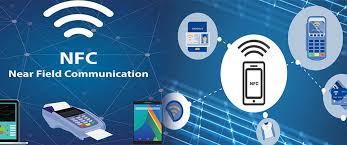
1. Surge in Contactless Payment Adoption
One of the primary forces propelling the NFC market is the rapid adoption of contactless payments. With consumers seeking fast, secure, and convenient transaction methods, NFC-enabled smartphones and payment cards have gained significant traction. The COVID-19 pandemic further intensified this trend as hygiene concerns fueled demand for touch-free solutions. Global financial institutions and retailers are embracing NFC to enhance customer experience and improve transaction efficiency. As digital wallets like Apple Pay, Google Pay, and Samsung Pay continue to expand, the reliance on NFC technology is expected to surge.
2. Growing Penetration of NFC-Enabled Smartphones
The widespread availability of NFC-enabled smartphones is a fundamental growth enabler. Leading smartphone manufacturers integrate NFC chips as a standard feature, facilitating mobile payments, peer-to-peer data transfer, and connectivity with smart devices. As smartphone penetration deepens globally, especially in emerging markets, NFC becomes more accessible to billions of users. The rising affordability of NFC components further supports integration across mid-range and entry-level smartphones, broadening the market potential.
3. Expanding Applications in Retail and Consumer Electronics
Retailers are leveraging NFC technology to create interactive and personalized shopping experiences. From smart shelves to NFC tags on products, this technology enables instant product information, loyalty program participation, and contactless checkout. Consumer electronics, including smartwatches, fitness trackers, and wireless headphones, are increasingly equipped with NFC, offering seamless pairing, device control, and payment functionalities. The growing ecosystem of NFC-compatible devices enhances the technology's appeal across consumer applications.
4. Integration into Public Transport and Smart Infrastructure
Urban mobility systems are integrating NFC to enable efficient ticketing and access control. NFC-based transit cards and mobile apps provide commuters with convenient, secure, and contactless travel experiences. Cities worldwide are adopting NFC in smart infrastructure projects, including building access, identity verification, and digital key solutions for hotels and vehicles. This integration supports the development of smart cities, where interconnected devices enhance operational efficiency and user convenience.
5. Enhanced Security and Data Privacy Features
Security concerns often influence technology adoption, and NFC's robust security protocols play a pivotal role in market growth. NFC operates within a short-range, reducing the risk of interception. Additionally, advanced encryption and tokenization technologies secure payment and data transfer processes. As cybersecurity becomes a priority across industries, NFC's built-in security features make it an attractive choice for sensitive transactions and applications, especially in financial services and healthcare.
6. Rising Demand for IoT Connectivity
The growth of the Internet of Things (IoT) ecosystem fuels demand for reliable, low-power, and secure connectivity options, with NFC meeting these requirements. NFC facilitates easy device pairing, configuration, and secure data exchange within IoT networks. From smart homes to industrial automation, NFC simplifies connectivity between devices, driving its adoption across various IoT use cases. As IoT deployments expand globally, NFC's role in enabling seamless device interactions will strengthen.
7. Government Initiatives and Regulatory Support
Governments worldwide are supporting the development of contactless payment infrastructure and smart identification systems, boosting NFC adoption. Regulatory bodies encourage standardization and interoperability, which fosters consumer trust and market scalability. Initiatives promoting digital payments, especially in developing regions, create favorable conditions for NFC proliferation across public and private sectors.
Conclusion
The near field communication market is poised for sustained growth as consumers, businesses, and governments embrace contactless technologies. Key drivers such as increasing mobile payment adoption, NFC-enabled device proliferation, and expanding applications across industries underscore the technology's relevance. With enhanced security features, integration into smart infrastructure, and rising IoT connectivity demands, NFC is set to transform how people and devices interact in a digital-first world. As market dynamics evolve, stakeholders investing in NFC innovation and infrastructure will play a central role in shaping the future of contactless communication.
0 notes
Text
How NFC Readers Are Changing Our World

1. Introduction: AIDC India Leading the NFC Reader Revolution
The world is rapidly shifting towards contactless technology. From mobile payments to digital access cards, NFC Readers are quietly reshaping how we interact with our environment. NFC, or Near Field Communication, allows devices to exchange data when they are brought close together. Whether you're tapping a phone to pay or scanning a card to enter a building, NFC is making life faster, safer, and smarter.
AIDC Technologies India, a trusted name in automation and identification solutions, is at the forefront of this transformation. With decades of experience in barcode, RFID, and data capture technologies, AIDC is now driving the adoption of NFC Readers across industries in India. Their mission is clear—enable secure, contactless interaction through reliable and easy-to-integrate NFC technology.
2. What Are NFC Readers? Understanding the Technology
NFC Readers are electronic devices that read data from NFC-enabled tags, cards, or smartphones. The technology is built on short-range wireless communication, typically within a range of 4–10 centimeters. The reader either reads information or writes data onto the NFC chip, depending on the application.
AIDC Technologies India offers a wide range of NFC Readers that can be used in retail, transportation, education, healthcare, and corporate sectors. With easy setup and seamless integration, AIDC’s NFC solutions help businesses go contactless without disrupting their existing operations.
3. AIDC’s Contribution to NFC Innovation in India
As digital transformation sweeps across India, AIDC Technologies India is playing a key role in helping businesses adapt. The company has developed NFC-based solutions that are reliable, user-friendly, and scalable. AIDC focuses on designing NFC Readers that support fast data exchange, enhanced security, and flexible deployment options.
From standalone NFC terminals to mobile-integrated readers, AIDC provides complete solutions including software, hardware, and ongoing technical support. By doing so, they help organizations improve customer experience, reduce manual work, and stay future-ready.
4. NFC Readers in Retail: AIDC’s Role in Enhancing Customer Experience
Retailers are among the earliest adopters of NFC technology. AIDC helps them offer faster checkouts, contactless payments, and personalized promotions. When customers tap their smartphones or cards at an NFC Reader, the transaction is completed instantly—no swiping, no PINs.
AIDC also enables loyalty programs through NFC-enabled smart cards. These cards can store reward points, membership details, and purchase history. With NFC Readers installed at billing counters and entry points, retailers can track customer activity and offer tailored services, boosting both satisfaction and sales.
5. Securing Access with AIDC NFC-Based Authentication Systems
Security and access control are critical in today’s digital world. AIDC provides advanced authentication solutions using NFC technology. Offices, campuses, and data centers now use NFC Readers for secure entry and employee identification.
With AIDC’s NFC systems, employees can use badges, phones, or wearables to unlock doors and log their attendance. The system records every entry in real time and can be integrated with HR and payroll software. These solutions not only improve security but also reduce administrative workload and eliminate time fraud.
6. Smarter Public Transport: AIDC’s NFC Readers in Ticketing
Public transportation systems are becoming more efficient thanks to NFC technology. With AIDC’s NFC Readers, passengers can tap a card or phone to pay for rides, check schedules, or validate tickets. No more paper tickets or long queues.
AIDC has worked with various state and private transport agencies to introduce NFC-enabled ticketing in buses, metros, and parking systems. Their solutions are rugged, fast, and easy to maintain—ideal for high-traffic environments. The result is a smoother travel experience for commuters and better data management for transit authorities.
7. Healthcare Transformation Through AIDC NFC Readers
In healthcare, speed and accuracy save lives. AIDC Technologies India offers NFC Readers that simplify patient identification, medication tracking, and access control in hospitals. Doctors and nurses can tap a patient’s NFC-enabled wristband to instantly view medical history and treatment plans.
These systems reduce paperwork, minimize human error, and ensure secure access to patient records. AIDC’s NFC solutions also help manage pharmacy inventory, lab samples, and staff attendance, bringing operational efficiency to every corner of the healthcare ecosystem.
8. AIDC India’s NFC Readers in Education and Corporate Campuses
Schools, universities, and corporate campuses benefit greatly from AIDC’s NFC technology. With smart ID cards and mobile-based access systems, institutions can manage attendance, library checkouts, and even cashless canteen payments.
AIDC installs NFC Readers at classroom doors, libraries, and labs to ensure secure access for students and staff. These systems can be linked with learning management systems and administrative software, allowing institutions to track student engagement and streamline resource usage.
9. Why AIDC NFC Readers Outperform Traditional Scanning Systems
Compared to older technologies like magnetic strips or QR codes, NFC Readers offer superior convenience and security. They don’t require physical contact, are faster to scan, and are harder to duplicate. AIDC Technologies India takes these benefits further with durable, high-performance devices that are built for Indian conditions.
Whether it’s rain, dust, or heat—AIDC’s NFC Readers work reliably in all environments. They support multiple protocols and are compatible with Android and Windows devices, making them a versatile choice for businesses of all types.
10. Future Outlook: AIDC’s Vision for a Connected NFC World
As the world moves toward smart cities and IoT-based systems, NFC technology will play a central role. AIDC Technologies India is already investing in next-generation NFC Readers with built-in Bluetooth, Wi-Fi, and AI capabilities.
Their vision is to create a connected ecosystem where data flows seamlessly between people, devices, and systems. In the near future, expect to see AIDC’s NFC solutions powering everything from smart homes and offices to digital identity platforms and intelligent transportation systems.
About AIDC Technologies India
AIDC Technologies India is a leading provider of automation, identification, and tracking solutions. The company specializes in barcode systems, RFID solutions, POS integration, and now—advanced NFC Readers. With decades of experience and a client base across retail, healthcare, logistics, and government, AIDC delivers end-to-end solutions that boost efficiency and reduce manual work. Their mission is to help businesses embrace the future with reliable, scalable, and smart technology.
Call to Action
Ready to go contactless? Upgrade your operations with secure, fast, and reliable NFC Readers from AIDC Technologies India.
#FutureWithNFC#SmartConnectivity#NFCInnovation2025#ContactlessTechnology#NFCInEverydayLife#NextGenNFCReaders
0 notes
Text
NFC Juice Market Segmentation Application, Technology & Market Analysis Research Report To 2035
The NFC juice market is poised for remarkable growth, emerging as one of the fastest-expanding segments within the global beverage industry. Valued at USD 3.04 billion in 2025, the market is projected to reach USD 6.69 billion by 2035, progressing at a robust CAGR of 8.2% during the forecast period.
This momentum is largely propelled by shifting consumer preferences toward healthy, convenient, and clean-label beverages. NFC juices, derived directly from fresh fruit and vegetable extracts without undergoing concentration or the addition of artificial ingredients, offer superior taste and nutritional value. The growing popularity of these natural beverages underscores a broad consumer movement toward transparency, plant-based nutrition, and better-for-you drink options.
Stay Informed – Request a Sample Copy for Exclusive Insights: https://www.futuremarketinsights.com/reports/sample/rep-gb-18027
Key NFC Juice Market Trends Highlighted
Clean Label Preference: Consumers are increasingly drawn to NFC juices due to their minimal processing, absence of preservatives, and 100% fruit content.
Premium Positioning: NFC juices are positioned as premium health beverages, leading to increased demand in high-income demographics and urban markets.
Flavored Varieties: Innovations in flavors—such as tropical blends, mixed berries, and superfruit infusions—are expanding the market’s appeal.
On-the-Go Packaging: The rising demand for convenient, single-serve juice packs is contributing to a surge in retail sales across supermarkets and online platforms.
Sustainability Focus: Brands are increasingly investing in eco-friendly packaging and sustainable sourcing practices to align with environmental concerns of the target audience.
NFC Juice Industry Developments
Major players are focusing on new product launches, packaging innovations, and geographic expansion to capture a broader consumer base. For instance, several European companies have introduced organic NFC juices in biodegradable packaging, catering to the eco-conscious consumer.
Partnerships between juice manufacturers and e-commerce platforms have accelerated online availability, while cold chain logistics advancements are improving product shelf life and distribution. Additionally, mergers and acquisitions among global beverage giants and niche organic juice brands are reshaping the competitive landscape.
Key Takeaways of the Report
The NFC juice market is forecast to double in value from 2025 to 2035, driven by health trends and product innovation.
Citrus juices, especially orange and lemon, remain top sellers due to their flavor profile and immunity-boosting properties.
Emerging economies, particularly in Asia-Pacific, are witnessing rapid adoption due to rising disposable income and urbanization.
Distribution channels like online retail and convenience stores are gaining traction, offering easy access to a broader audience.
NFC Juice Market Drivers
The global market is benefiting from increasing health awareness and demand for minimally processed beverages. NFC juices are made directly from freshly extracted fruits and vegetables, without reconstitution or chemical additives. This results in superior sensory characteristics, retaining the original aroma, flavor, and nutrients of the fruit.
Consumers are increasingly turning to plant-based, natural drink alternatives that support a healthy lifestyle. Available in popular flavors such as apple, orange, and lemon, NFC juices are perceived as a healthier choice compared to juices made from concentrate. The clean-label trend, along with a growing preference for organic and non-GMO certified beverages, continues to stimulate global demand.
Your Competitive Advantage Starts Here – Access Full Report: https://www.futuremarketinsights.com/reports/nfc-juice-market
NFC Juice Market Regional Insights
North America and Europe dominate the NFC juice market due to established health and wellness trends, a high concentration of premium beverage brands, and strong retail infrastructure. The United States remains a major contributor, with a CAGR of 4.8% from 2025 to 2035, driven by an expanding base of health-conscious consumers and demand for convenient breakfast beverages.
In Europe, Germany (4.3%), France (4.5%), and the UK (4.2%) are leading markets, backed by a strong preference for organic and cold-pressed juices. Italy and other Mediterranean countries also show steady demand due to the traditional consumption of fresh fruit drinks.
Asia-Pacific is witnessing the fastest growth. China, with a projected CAGR of 5.3%, leads the region, fueled by urbanization and rising disposable incomes. South Korea (5%) and Japan (4.6%) are also key markets, with increasing demand for premium and imported health beverages. Australia (4%) and New Zealand (3.9%) are experiencing gradual yet steady growth in NFC juice consumption, especially among younger consumers.
Country-wise CAGR Analysis (2025 to 2035):
USA: 4.8%
UK: 4.2%
France: 4.5%
Germany: 4.3%
Italy: 4.1%
South Korea: 5.0%
Japan: 4.6%
China: 5.3%
Australia: 4.0%
New Zealand: 3.9%
Competition Outlook
The global NFC juice market is moderately fragmented, with a mix of multinational corporations and regional players. Key companies are diversifying their product lines with organic, sugar-free, and superfruit-infused variants to stay competitive.
Mergers and strategic alliances are common, with large players acquiring local juice producers to enhance their footprint and appeal to region-specific tastes. R&D investments in cold-pressed technology, extended shelf life, and sustainable packaging are gaining prominence as companies aim to differentiate in a competitive landscape.
Notable players are
Tropicana Products (PepsiCo)
The Coca-Cola Company (Innocent Drinks)
Eckes-Granini Group
Suja Life, LLC
AMC Group
Top Segments Studied in the NFC Juice Market Report
By Product Type:
By product type, the industry is classified as fresh fruits, fresh vegetables, and blends.
By Product Claim:
By product claim, the industry is classified as organic and conventional.
By End-Use Application:
By end use application, the industry is classified as non-alcoholic beverages, alcoholic beverages, bakery & confectionery, dairy & frozen desserts, and others.
By Region:
By region, the industry is divided as North America, Latin America, Europe, East Asia, South Asia, Oceania, and Middle East & Africa.
0 notes
Text
Mobile Printer Market Size Accelerating On-the-Go Printing for Smart Workforces
The Mobile Printer Market Size is transforming how modern enterprises and field professionals handle documentation and labeling in real-time, regardless of location. From retail and logistics to healthcare and manufacturing, mobile printers are empowering workforce mobility and operational efficiency.
According to Market Size Research Future, the global mobile printer Market Size is expected to reach USD 9.1 billion by 2030, registering a CAGR of 7.5% during the forecast period (2023–2030). The surge in demand for portable printing solutions that deliver quick, wireless, and high-quality outputs is driving this expansion.
Market Size Overview
Mobile printers, also known as portable printers, are compact, lightweight devices that offer printing capabilities via wireless connections like Bluetooth, Wi-Fi, or mobile networks. These devices are ideal for printing receipts, invoices, barcodes, labels, and tickets directly from smartphones, tablets, or laptops.
The integration of IoT, cloud computing, and mobile devices across field service, transportation, and retail operations continues to fuel Market Size adoption. Moreover, businesses are increasingly prioritizing mobility solutions that reduce downtime, improve workflow, and enable real-time data output in mission-critical environments.
Key Market Size Drivers
1. Rising Demand in E-commerce and Logistics
With the e-commerce boom, mobile printers are essential tools for generating shipping labels, tracking barcodes, and delivery confirmations—reducing human error and accelerating package processing.
2. Growth in Retail and Point-of-Sale (POS) Applications
Retailers use mobile printers to print customer receipts, shelf labels, and promotional tags on the shop floor, enhancing both service speed and customer experience.
3. Increasing Field Workforce Mobility
Mobile printers empower field workers—such as utility technicians, health workers, and law enforcement officers—to generate documentation on-site, improving productivity and compliance.
4. Technological Advancements
Recent innovations, including Bluetooth Low Energy (BLE), NFC-enabled printing, and cloud-based management tools, have significantly improved the usability and performance of mobile printers.
Market Size Segmentation
By Output:
Thermal Printers
Inkjet Printers
Laser Printers
By Technology:
Bluetooth Printing
Wi-Fi Direct Printing
Cloud Printing
By End-User:
Retail
Logistics & Transportation
Healthcare
Hospitality
Manufacturing
Government and Public Safety
Regional Insights
North America
North America holds the largest Market Size share, driven by the early adoption of mobile printing technologies across logistics, retail, and healthcare.
Europe
In Europe, stringent documentation regulations in public services and healthcare are boosting demand for on-the-go printing solutions.
Asia-Pacific
The Asia-Pacific region is projected to witness the fastest growth, fueled by rapid urbanization, expanding retail Market Size s, and government digitalization initiatives in countries like China, India, and Japan.
Competitive Landscape
Top players in the mobile printer Market Size are focused on enhancing device connectivity, battery life, and cloud integration. Key companies include:
Brother Industries, Ltd.
HP Inc.
Zebra Technologies Corporation
Seiko Epson Corporation
Canon Inc.
Bixolon Co., Ltd.
Toshiba Tec Corporation
Printek LLC
Fujitsu Ltd.
Honeywell International Inc.
These companies are launching lightweight, durable models equipped with IoT-enabled remote management and analytics for enterprise use cases.
Opportunities and Challenges
Opportunities:
Expansion in emerging Market Size s with mobile-first business models
Integration with cloud-based ERP and CRM systems
Growth of smart cities and digital identity management
Challenges:
High initial investment in ruggedized models
Limitations in battery life and media capacity
Security vulnerabilities in wireless networks
Conclusion
The Mobile Printer Market Size is poised to redefine field operations and real-time printing efficiency in a digitally connected world. By integrating smart features, wireless technologies, and compact designs, mobile printers are enabling industries to keep pace with the demands of a fast-moving, decentralized workforce.
Companies that embrace mobile printing technologies will not only reduce operational bottlenecks but also gain a competitive advantage through increased mobility, faster service delivery, and improved customer satisfaction.
Trending Report Highlights
Explore other high-growth technology and electronics Market Size s:
Chip Resistor Market Size
Digital Thermometer Market Size
Commercial Display Market Size
Connected Living Room Market Size
Consumer Electronic Biometric Market Size
Conveyor Monitoring Market Size
Data Center GPU Market Size
Deep Learning Chip Market Size
Display Driver Integrated Circuit Market Size
DRAM Module Component Market Size
EAS Antennas Market Size
Optical Time Domain Reflectometer Market Size
Acoustic Camera Market Size
Advancement in Camera Technologies Market Size
0 notes
Text
North America Smart Clothing Market Size, Segments, Growth and Trends by Forecast to 2027

The market dynamics in North America indicate a robust growth trajectory. As of recent estimates, the market is expected to grow from a few hundred million dollars in valuation to over two billion dollars within a span of less than a decade. This rapid growth is attributed to increased research and development activities, consumer acceptance of wearable technology, and cross-sector collaborations. Academic and industrial partnerships are focusing on the development of more comfortable, durable, and washable smart garments, which are essential for widespread commercial adoption. Enhanced battery life, flexible circuitry, and data security are among the key areas being addressed to improve product performance and user experience.
The North America Smart Clothing Market is experiencing robust growth driven by advancements in wearable technology, growing health awareness, and rising adoption of smart fitness and medical monitoring solutions. As consumer interest in connected wearables surges, the North America Smart Clothing Market is poised for continued expansion across various segments such as sportswear, activewear, and healthcare garments. This trend is being fueled by the integration of innovative sensors, fabrics, and microelectronic components that enhance functionality and real-time data tracking.
One of the key drivers for the North America Smart Clothing Market is the increasing health consciousness among consumers. Smart clothing equipped with biometric sensors is helping individuals monitor heart rate, respiratory rate, body temperature, and physical activity in real time. These features make such garments particularly appealing for athletes and fitness enthusiasts. The North America Smart Clothing Market is also benefiting from partnerships between sportswear manufacturers and tech firms that aim to create high-performance clothing that supports training optimization and injury prevention.
Moreover, the healthcare sector is significantly contributing to the growth of the North America Smart Clothing Market. Medical smart garments are being developed for remote patient monitoring, enabling healthcare providers to gather continuous health data without the need for hospital visits. The elderly population, in particular, is reaping the benefits of smart clothing designed for fall detection and vital sign monitoring, making the North America Smart Clothing Market essential for improving patient outcomes and supporting home-based care.
📚 𝐃𝐨𝐰𝐧𝐥𝐨𝐚𝐝 𝐒𝐚𝐦𝐩𝐥𝐞 𝐏𝐃𝐅 𝐂𝐨𝐩𝐲@ https://www.businessmarketinsights.com/sample/TIPRE00014182
In addition to fitness and healthcare, the military and defense sectors are exploring the North America Smart Clothing Market for its potential to enhance soldier safety and performance. Smart uniforms embedded with communication tools and sensors can monitor physical stress, hydration levels, and even exposure to hazardous environments. This diversification of application areas is further accelerating the momentum of the North America Smart Clothing Market.
The North America Smart Clothing Market is also being shaped by advancements in textile technologies and connectivity solutions such as Bluetooth, NFC, and Wi-Fi. These innovations enable seamless communication between garments and smartphones or cloud platforms, facilitating easy access to data and personalized insights. As the demand for data-driven lifestyles increases, so does the reliance on connected apparel, reinforcing the importance of the North America Smart Clothing Market in everyday life.
The market’s growth is supported by consumer demand for stylish yet functional clothing. Fashion brands are increasingly investing in the North America Smart Clothing Market, merging aesthetics with cutting-edge tech to appeal to the modern consumer. From smart jackets that regulate temperature to shirts that monitor posture, the possibilities are expanding.
In conclusion, the North America Smart Clothing Market is set for remarkable growth, driven by a convergence of health, technology, and lifestyle trends. With rising consumer interest and ongoing R\&D investments, the North America Smart Clothing Market is transforming the way people interact with clothing. As innovation continues, the North America Smart Clothing Market will likely redefine apparel as a key player in the wearable tech ecosystem, marking a new era of intelligent fashion and functionality.
North America Smart Clothing Regional Insights
The geographic scope of the North America Smart Clothing refers to the specific areas in which a business operates and competes. Understanding local distinctions, such as diverse consumer preferences (e.g., demand for specific plug types or battery backup durations), varying economic conditions, and regulatory environments, is crucial for tailoring strategies to specific markets. Businesses can expand their reach by identifying underserved areas or adapting their offerings to meet local demands. A clear market focus allows for more effective resource allocation, targeted marketing campaigns, and better positioning against local competitors, ultimately driving growth in those targeted areas.
Market Overview and Dynamics
The pandemic due to outbreak of COVID-19 had negatively affected the economic stability in North American countries, so far, the US is the worst hit country in North America. In order to control the outbreak of corona virus the governments across North America initiated various measures such as travel bans, factories and business shutdowns, and lockdowns. These containment measure ultimately hampered the projected revenue generation and growth opportunities in North America. Furthermore, the service sector had witnessed significant impact of the global pandemic owing to decline in services along with laying off of employees across different service verticals across the distribution channel such as retailers, suppliers, distributors and delivery providers. The retailers and brands are facing various short-term challenges regarding health and safety, supply chain, labor force, cash flow, consumer demand, and marketing. Furthermore, the rising number of cases continue to negatively impact the production, distribution and continue operation of supply chain for smart clothing market across the North American region.
𝐓𝐡𝐞 𝐋𝐢𝐬𝐭 𝐨𝐟 𝐂𝐨𝐦𝐩𝐚𝐧𝐢𝐞𝐬
Carre Technologies Inc. (Hexoskin)
Sensoria Inc.
Under Armour, Inc.
WEARABLE X
Jabil Inc.
Siren Care, Inc.
Google LLC
Key Market Segments
In terms of type, the passive accounted for the largest share of the North America smart clothing market in 2019. In terms of product, the apparel segment held a larger market share of the North America smart clothing market in 2019. On the basis of connectivity, the Bluetooth segment held a larger market share of the North America smart clothing market in 2019. Further, the sports & fitness segment held a larger share of the market based on end user in 2019.
About Us-
Business Market Insights is a market research platform that provides subscription service for industry and company reports. Our research team has extensive professional expertise in domains such as Electronics & Semiconductor; Aerospace & Defense; Automotive & Transportation; Energy & Power; Healthcare; Manufacturing & Construction; Food & Beverages; Chemicals & Materials; and Technology, Media, & Telecommunications.
0 notes
